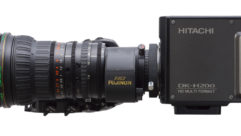GAMMA: a closer look
Sep 1, 2000 12:00 PM,
Josh Kairoff
Everything in video is not always as it seems. Establishing an image that locks up and is recognizable is sometimes only part of what is necessary. In much the same manor as audio pre-equalization, visual signals are pre-adjusted to compensate for the characteristics of their anticipated display devices.
Still-and motion-picture photography usually ends up being projected or printed. For video and computer use, the most common display device has been the CRT. All CRTs have a similar nonlinear response for converting input voltage to output light levels. Because of this, every system that is designed to reproduce images accurately using CRTs requires some sort of pre-adjustment to compensate for the CRT’s inherent characteristics. Not every system using CRTs for display, however, has implemented pre-equalization compensation in the same way or at the same step in the process. Most computers, for instance, use a look-up table (LUT) in the graphics card to apply the appropriate pre-equalization adjustments.
Many years ago when I used to work in master control for a certain big news network, I was told never to play with the gamma adjustment on the camera control units (CCU). “What’s gamma?” I curiously asked. I was told that it is an adjustment to set the voltage-to-light ratio and not to touch it. Well, I did, ultimately making the video image look poor, and I got a bit of a talking to.
What exactly is gamma? Webster defines gamma as “the degree of contrast of a developed photographic image or of a television image.” Nice, but not quite descriptive enough. Mathematically, the gamma number we see is the exponent value (the number above and to the right) of a power function equation defining the transfer function response of a display. The transfer function of a device is the input-to-output relationship of that device. Luminance levels are usually measured in linearly sequenced increments, but our perception of relative luminance levels (called lightness) is logarithmic. In the visual world, all things being equal, the dilemma that explains the differences between light level captured on one device and reproduced on another is called gamma. Gamma values are used to define, identify and modify the volt-age-to-light relationship of image capture and display devices so that the intensity quality of what goes in matches what comes out.
Similar to how people hear sound, we see changes in lower light levels much easier than higher light levels. As an example, everything else being equal, we see the change between 0.5 lumens and 0.6 lumens as a two-fold increase, but on the high end, it takes a change from 1,000 lumens to 2,000 lumens for us to see the same perceivable amount of change. This is, of course, all relative to the overall light levels and dynamic range of the entire viewing area or screen.
The gamma ratio is the logarithmic relationship between brightness and voltage. If a system has a gamma of 1.0, its input-to-output levels are linearly proportional. At a gamma of 0.5, changes in low light levels are more responsive than changes in high light levels. At a gamma of 2.2, changes in low light levels are less responsive than changes in high light levels.
Historically, gamma correction in video has always occurred at the camera or in telecine. The image signals from the camera were gamma corrected (or, more accurately, pre-adjusted) in anticipation of the reverse happening when viewed on a television CRT. Anyone manufacturing a non-CRT television who wanted the images to look correct needed to add the ability to mimic a CRT’s nonlinear response. If the non-CRT display was designed to display both video and computer, than video gamma emulation was used on the video input, and computer gamma emulation was used on the computer inputs.
In video, film, print or paint, be it analog or digital, the way we actually see light intensity and how it’s quantified has always been a problem. Every industry producing visual products has had to develop ways of defining, measuring and reproducing intensity with predictable results. These standards, although all designed with similar goals, tend to be unique to each medium. With all the different systems designed for many different purposes and environments, varying amounts of pre-adjustment are required to produce good results in each system. Each industry used the most appropriate procedures for its applications. As long as each system stayed a closed loop, everything worked fine. When the systems do not stay closed, and signals become cross compatible, then inappropriately pre-adjusted content can accidentally find its way to a display where it will be incorrectly represented. As cheaper technology has become more available in video, the ability to abuse all sorts of things has given way to inadvertently introducing cross medium compatibility problems.
When a scene is captured on a video camera, stored and edited on videotape and then displayed on a television, the project is, without doubt, a video. Now, what if a given scene is captured on film, transferred to video, edited on a computer, stored on a DVD-Video and displayed as a line-doubled signal on a projection television? As what medium type would the project be classified? At each point in this hypothetical project, the image signal is being converted to a different and incompatible medium. If done incorrectly, each conversion can compound inappropriate pre-adjustments and degrade the accuracy of the end result.
One of the easiest ways to see gamma incorrectly is to use a video line doubler on a display that is capable of displaying both computer and video. The line-doubled video coming in at 31.5 kHz @ 60 Hz can easily be misinterpreted as VGA computer. Switching the display between PC and video modes will result in a noticeable change in both the intensity and dark image characteristics of the program material.
The goal of matched pre and post equalization is to overcome some limitations and preserve the qualities that would otherwise be distorted by the anticipated mediums. When the individual mediums behave as expected, everything works great. When things are not as expected (like when Dolby is left on for a non-Dolby tape or left off for a Dolby-encoded tape), then the content can be distorted by the pre- and the post-equalization mismatch.
Although the result is not always disastrous, the reproduction is nevertheless inaccurate. Users can end up making incorrect and inappropriate adjustments to the reproduction equipment when, in fact, the core problem is overlooked. Other audio world examples of this concept are the RIAA phonograph equalization curve, tape bias voltages, Loudness contours, and even the way our ear responds to frequency amplitudes.
In the world of video there are references and test equipment to maintain conformity of levels but rarely are response or reproduction curves checked. After all, we have come to expect that content stays in the medium it was designed for. It’s when these mediums change that the potential for problems develops.
So what can we do about all this? First, learn to recognize what a gamma mismatch looks like. Second, when using content from different media, be aware that the intended display devices may all be different, and conversion to a single standard may be needed. Third, when appropriate, try to use displays that give you the ability to adjust their gamma response. Fourth and lastly, become familiar with (and create if necessary) some test images in different media. By using well-known images as a reference, inaccurate reproduction charestics can be more easily identified and corrected. Additionally, Charles Poynton has written (among other wonderful things) a good FAQ of gamma misunderstandings. Anyone working at the bleeding edge of displaying mixed media should check out his information at www.inforamp.net/-poynton/.









